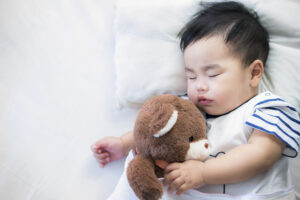When you buy through our links, we may earn a commission. Products or services may be offered by an affiliated entity. Learn more.
Do Babies Sleep More When Teething?
If you have an infant or toddler at home, chances are, you think about sleep a lot . Whether you’re adjusting to life with a new baby or hoping your toddler’s improved sleep habits are here to stay, you might be wondering what to expect when it comes to teething and sleep.
Do Teething Babies Tend to Sleep More?
Unfortunately for babies and their caregivers, teething can cause pain and discomfort that make it hard to sleep . In fact, scientific evidence suggests that more than 80% of infants and toddlers experience sleep disturbances when they are teething .
While teething schedules can vary significantly, most babies break their first tooth around 6 months of age, and all 20 “baby teeth” usually emerge by the time a child is 2.5 years old . Teething doesn’t happen constantly during this time . Rather, teeth emerge intermittently, sometimes in pairs or clusters .
In some children, teething may coincide with a rapid increase in height and weight called a growth spurt . If this happens, the child might experience fewer teething-related sleep disruptions—or might even sleep longer than usual. Sleep is vital for growth, and in the days leading up to a growth spurt, babies and toddlers often sleep up to 4.5 hours ]more than usual .
Help Your Baby Sleep Better With Pediatric Sleep Coaching

our partner at sleepdoctor.com
Learn More“Life-changing! My anxiety about my son’s sleeping habits were immediately reduced after talking to Sara. She went above and beyond to tailor a schedule to our goals, answer our questions, keep us on track, and check in to encourage us when we just thought we couldn’t do it anymore.”
Rachael B. – Verified Customer
Signs That Your Baby Started Teething
Sleep problems may be a sign that your baby is teething. Other common indicators that a tooth is emerging are:
- Drooling
- Rash on the chin or face
- Sucking or chewing fingers, toys, or other objects
- Reduced appetite
- Ear tugging
- Gum rubbing
- Fussiness or irritability
- Inflamed gums
Many caregivers also report fever, diarrhea, and vomiting during teething, but evidence suggests that these symptoms are not directly caused by tooth eruptions. They may be the result of developmental changes in immunity and behaviors like hand-sucking, which increase exposure to bacteria and viruses.
According to one study, babies tend to experience more teething symptoms during their initial tooth eruptions, but as they get older, they experience fewer symptoms .

How Long Does Teething Fussiness Last?
The fussiness associated with teething usually doesn’t last for more than eight days during any given tooth eruption. Teething symptoms—including drooling, lack of sleep, and irritability—tend to begin about four days before the tooth breaks through the gums and may continue for three days afterward. That said, symptoms tend to peak before the tooth emerges and gradually resolve over the course of the teething episode.
Tips to Soothe a Teething Baby Who Won’t Sleep
If teething discomfort is keeping your baby awake, there are several steps you can take to help them feel better so that both of you can get some rest.
- Comfort your baby: Hugging, holding, or snuggling with your baby may help reduce feelings of irritation and distress that interfere with sleep. Singing a lullaby or reading a bedtime story may also distract your baby from their discomfort.
- Apply pressure to your baby’s gums: Pressure tends to provide relief, so try massaging your baby’s gums with a clean finger or allowing your baby to chew a solid teething ring before they go to bed. You might also allow your baby to sleep with a pacifier that they can bite or chew in the night.
- Use cold to reduce pain and swelling: Allowing your baby to bite, suck, or eat something cold may help decrease inflammation. Try freezing a clean, damp washcloth or a teething toy and allowing your baby to chew on it. If your child eats solids, you can feed them cold, soft foods or allow them to chew on a refrigerated apple, carrot, or cucumber—just make sure to supervise them so that they don’t choke.
- Wipe away drool: Regularly remove drool with a soft cloth. This can help prevent a rash from developing and adding to your baby’s discomfort.
- Use over-the-counter pain relievers: If other methods do not work or your child is in so much pain that they cannot sleep, you can provide an age- and weight-appropriate dose of a pain reliever, such as infant’s acetaminophen or infant’s ibuprofen (after 6 months of age).
- If you know your baby is showing signs of teething, pre-medicate with a pain reliever prior to bedtime so the baby is capable of falling asleep and staying asleep overnight. If there is a wake-up, and there has been an appropriate amount of time since the last dose of medication, the baby can be dosed again. The infant only needs medication for a day or two while the gums are swollen. Once the tooth emerges, the pain typically subsides.
Teething Remedies to Avoid
There are several teething remedies that experts recommend avoiding for the safety of your child. These include:
- Using teething necklaces, which put babies at risk of choking or strangulation
- Lancing your baby’s gums
- Holding ice on your baby’s gums
- Rubbing aspirin, alcohol, or powders on your baby’s gums
- Using liquid- or gel-filled teething rings or toys
- Applying teething gels to children younger than 2 years of age
When to Contact A Pediatrician
If you find that you are unable to soothe your child, or if your child develops diarrhea or a fever, contact your ]pediatrician for guidance.
Expert Tip From Sleep Coach
To help your child sleep better while teething, it’s important to maintain a consistent bedtime routine and allow them to fall asleep on their own, even if they wake up during the night. Often, parents may offer more intervention, besides medication management, when their child wakes up due to pain, which can lead to more frequent wake-ups. This can cause confusion for the parents as they may not be sure if their child is waking up due to teething pain or because they are seeking the parent’s intervention. Therefore, it’s best to stick to a consistent routine and allow the child to fall asleep independently at bedtime and with each wake-up after the appropriate intervention is provided.

Still have questions? Ask our community!
Join our Sleep Care Community — a trusted hub of sleep health professionals, product specialists, and people just like you. Whether you need expert sleep advice for your insomnia or you’re searching for the perfect mattress, we’ve got you covered. Get personalized guidance from the experts who know sleep best.
References
11 Sources
-
Ball, H. L., Taylor, C. E., Thomas, V., Douglas, P. S. (2020). Development and evaluation of ‘Sleep, Baby & You’-An approach to supporting parental well-being and responsive infant caregiving
https://pubmed.ncbi.nlm.nih.gov/32764810/ -
A.D.A.M. Medical Encyclopedia. (2024, April 24). Teething. MedlinePlus.
https://medlineplus.gov/ency/article/002045.htm -
Memarpour, M., Soltanimehr, E., Eskandarian, T. (2015). Signs and symptoms associated with primary tooth eruption: a clinical trial of nonpharmacological remedies
https://pubmed.ncbi.nlm.nih.gov/26215351/ -
Consolini, D. M. (2023, September). Teething. Merck Manual Professional Version.
https://www.merckmanuals.com/professional/pediatrics/care-of-newborns-and-infants/teething -
Ogodescu, E., Popa, M., Isac, C., Pinosanu, R., Olaru, D., Cismas, A., Tudor, A., Miron, M. (2022). Eruption Timing and Sequence of Primary Teeth in a Sample of Romanian Children.
https://pubmed.ncbi.nlm.nih.gov/35328159/ -
Macknin, M. L., Piedmonte, M., Jacobs, J., Skibinski, C. (2000). Symptoms associated with infant teething: a prospective study
https://pubmed.ncbi.nlm.nih.gov/10742315/ -
Tham, E. K., Schneider, N., Broekman, B. F. (2017). Infant sleep and its relation with cognition and growth: a narrative review
https://pubmed.ncbi.nlm.nih.gov/28553151/ -
Lampl, M., Johnson, M. L. (2011). Infant growth in length follows prolonged sleep and increased naps
https://pubmed.ncbi.nlm.nih.gov/21532958/ -
Noor-Mohammed, R., Basha, S. (2012). Teething disturbances; prevalence of objective manifestations in children under age 4 months to 36 months
https://pubmed.ncbi.nlm.nih.gov/22143712/ -
U.S. Food and Drug Administration (2018, May 23). Safely Soothing Teething Pain and Sensory Needs in Babies and Older Children.
https://www.fda.gov/consumers/consumer-updates/safely-soothing-teething-pain-and-sensory-needs-babies-and-older-children -
Marcus, M. B. (2016, December 7). Baby teether study finds many contain potentially harmful chemicals. CBS News.
https://www.cbsnews.com/news/baby-teether-study-bpa-endocrine-disruptors-chemicals/




























